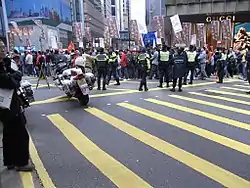Hong Kong new year marches
The New Year marches (Chinese: 元旦大遊行) are a fixture on the political calendar in Hong Kong. Thousands take to the streets demanding universal suffrage as part of the ongoing democratic development as well as to protest against further influence of mainland China in Hong Kong.

2010 march
In a 2009 directive from Beijing, the Hong Kong government said direct elections for the chief executive would come in 2017, and the legislature would not be fully elected until 2020.[1] Five pro-democracy camp legislators planned to resign en masse from Legislative Council of Hong Kong.[2] In December 2009, HK launched a proposal to increase the election committee seats for the chief executive from 800 to 1,200 individuals.[1] On 1 January 2010, protesters called for the release of Chinese activist Liu Xiaobo, drafter of Charter 08, was sentenced to 11 years in prison just a month earlier.[3][4] The protest also came four days after Donald Tsang, Hong Kong's chief executive, was given a warning by China’s leadership to resolve deep-rooted conflicts.[1]
Police security was put up around the Beijing liaison office in HK.[5] Layers of railings and human chains were set up protecting the building, and more than 1,000 police officers were deployed.[5] About 10 activists, mostly supporters of the League of Social Democrats, broke through a cordon and stormed into the liaison office.[5] Des Voeux Road was forced to close for an hour. Two police officers and one protester was injured.[5] The protesters did not leave until 7:45pm when league members were allowed to lay a mock coffin at the building's back entrance.[5]
Attendance
A mix reporting of different statistics on the number of people who participated. March organizers said more than 10,000 protesters turned out.[2] Police put the number at 4,000.[2] Pro-democracy camp said they attracted more than the expected 30,000 people.[1] Other sources also suggest 30,000 protesters in participation with 9,000 reported by the police.[6]
2013 march
Up to 130,000 people have held rival marches on 1 January 2013 in Hong Kong both for and against the city's chief executive CY Leung. Those protesting against him said he should step down over allegations he lied about illegal renovations and extensions to his mansion. Leung secretly extended his $64 million home without getting government planning permission or paying real estate fees. He is accused of lying about it during last year's election campaign. In response, Leung immediately erected a false wall to block access to the unauthorised extension, before awaiting official investigation. Leung claimed he had solved the problem as the illegal extension "did not exist anymore", but the action led to suspicion of destroying evidence. Leung had also been widely accused of hypocrisy over the issue, as he won the election on 1 July last year by criticising his opponent, Henry Tang for the unauthorised building of a huge basement for a villa held in the name of his wife. Other reasons included universal suffrage, greater democracy, the widening wealth gap and Beijing's meddling in Hong Kong affairs. Organisers of the march calling for Leung's impeachment estimated their numbers at 130,000, although police put the figure at a lower 26,000 at the march's peak.
Supporters of Leung who organised a follow up march argued that he was beginning to address deep-rooted social issues. They also suggested that democracy is a Western concept, which is not compatible with fast economic development or Chinese culture. Supportive ally organisers reported that over 60,000 turned out, although police again reported a lower figure of 8,000.[7]
2018 march
The march was organized by the Civic Human Rights Front. More than 10 pro-democracy groups and the camp's co-location concern group joined the march, as well as four disqualified lawmakers and Occupy movement leader Benny Tai Yiu-ting. The marchers protested seven social issues, including the West Kowloon co-location arrangement, the recent amendments to the Legislative Council's rules of procedure and the potential enactment of Basic Law Article 23. Organizers said 10,000 joined the march, while police said the turnout was 6,000.[8]
2020 march
Main article:Timeline of the 2019–20 Hong Kong protests (January 2020)
See also
References
- FT.com. "Thousands demand HK poll reform." Financial Times Retrieved on 2010-01-02.
- Msnbc.com. "Msnbc.com." Hong Kong marchers call for Democracy Now!. Retrieved on 2010-01-02.
- "China Sentences Dissident to 11 Years for Subversion". The New York Times.
- NPR.org. ""Thousands Demand Democracy In Hong Kong". NPR.org. Retrieved on 2010-01-02.
- "Multitudes march for universal suffrage". South China Morning Post. Retrieved on 2010-01-02.
- Metroradio.com.hk. "Metroradio.com.hk." 警方指元旦大遊行約有九千人參加 . Retrieved on 2010-01-02.
- "Tens of thousands march in rival protests over Hong Kong's leader (PHOTOS)". RT. Retrieved 18 February 2014.
- "Civic Square standoff". The Standard (Hong Kong). 2018-01-02.
External links
- (in Chinese)#0101hk Twitter account
Internet video
- (in Chinese)2010元旦大遊行(2)長毛勇救陳巧文
- (in Chinese)2010元旦大遊行(3)長毛呼籲群眾注意安全
- (in Chinese)2010元旦大遊行(4) 陳巧文誣蔑長毛抽水
- (in Chinese)長毛 vs 陳巧文 + 中大搽小陰評論@NOW新聞
- (in Chinese)元旦大遊行社民連.抬自製棺材到中聯辦.黃毓民叫口號01.01.2010